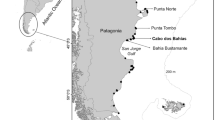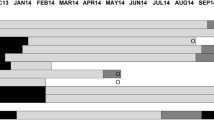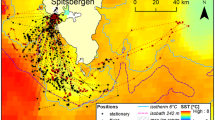Abstract
The foraging distributions of 20 breeding emperor penguins were investigated at Pointe Géologie, Terre Adélie, Antarctica by using satellite telemetry in 2005 and 2006 during early and late winter, as well as during late spring and summer, corresponding to incubation, early chick-brooding, late chick-rearing and the adult pre-moult period, respectively. Dive depth records of three post-egg-laying females, two post-incubating males and four late chick-rearing adults were examined, as well as the horizontal space use by these birds. Foraging ranges of chick-provisioning penguins extended over the Antarctic shelf and were constricted by winter pack-ice. During spring ice break-up, the foraging ranges rarely exceeded the shelf slope, although seawater access was apparently almost unlimited. Winter females appeared constrained in their access to open water but used fissures in the sea ice and expanded their prey search effort by expanding the horizontal search component underwater. Birds in spring however, showed higher area-restricted-search than did birds in winter. Despite different seasonal foraging strategies, chick-rearing penguins exploited similar areas as indicated by both a high ‘Area-Restricted-Search Index’ and high ‘Catch Per Unit Effort’. During pre-moult trips, emperor penguins ranged much farther offshore than breeding birds, which argues for particularly profitable oceanic feeding areas which can be exploited when the time constraints imposed by having to return to a central place to provision the chick no longer apply.









Similar content being viewed by others
References
Adams NJ, Brown CR (1990) Energetics of moult in penguins. In: Davis LS, Darby JT (eds) Penguin biology. Academic, San Diego, pp 297–315
Ancel A, Kooyman GL, Ponganis PJ, Gendner JP, Lignon J, Mestre X, Huin N, Thorson PH, Robisson P, Le Maho Y (1992) Foraging behavior of emperor penguins as a resource detector in winter and summer. Nature 360:336–339
Austin D, Bowen WD, McMillan JI, Iverson SJ (2006) Linking movement, diving, and habitat to foraging success in a large marine predator. Ecology 87(12):3095–3108
Bannasch R, Wilson RP, Culik B (1994) Hydrodynamic aspects of design and attachment of a back-mounted device in penguins. J Exp Biol 194:83–96
Birt VL, Birt TP, Goulet D, Cairns DK, Montevecci WA (1987) Ashmole’s halo: direct evidence for prey depletion by a seabird. Mar Ecol Prog Ser 40:205–208
Bost CA, Handrich Y, Butler PJ, Fahlman A, Halsey LG, Woakes AJ, Ropert-Coudert Y (2007) Changes in dive profiles as an indicator of feeding success in king and Adélie penguins. Deep Sea Res II 54:248–255
Chappell MA, Shoemaker VH, Janes DN, Bucher TL, Maloney SK (1993) Diving behavior during foraging in breeding Adélie penguins. Ecology 74:1204–1215
Culik BM, Wilson RP, Bannasch R (1994) Underwater swimming at low energetic cost by Pygoscelid penguins. J Exp Biol 197:65–78
Georges JY, Guinet C, Jouventin P, Weimerskirch H (1997) Satellite tracking of seabirds: interpretation of activity pattern from the frequency of satellite location. Ibis 139:403–405
Groscolas R (1978) Study of moult fasting followed by an experimental forced fasting in the emperor penguin Aptenodytes forsteri: relationship between feather growth, body weight loss, body temperature and plasma fuel levels. Comp Biochem Physiol 61A:287–295
Hull CL (2000) Comparitive diving behaviour and segregation of the marine habitat by breeding royal penguins, Eudyptes schlegeli, and eastern rockhopper penguins, Eudyptes chrysocome filholi, at Macquarie Island. Can J Zool 78:333–345
Isenmann P (1971) Contribution à l´éthologie et à l´écologie du manchot empereur à la colonie de Pointe Géologie. Oiseau Rev Fr Ornithol 41:9–64
Isenmann P, Jouventin P (1970) Eco-éthologie du manchot empereur (Aptenodytes forsteri) en comparaison avec le manchot Adélie (Pygoscelis adéliae) et le manchot royal (Aptenodytes patagonica). L´Oiseau et la R F O 40:136–159
Jaquet N, Whitehead H (1999) Movements, distribution and feeding success of sperm whales in the Pacific Ocean, over scales of days and tens of kilometers. Aquat Mamm 25:1–13
Jouventin P (1982) Visual and vocal signals in penguins, their evolution and adaptive characters. In: Parey P (ed) Advances in ethology, Berlin, pp 149
Jouventin P, Capdeville D, Cuenot-Chaillet F, Boiteau C (1994) Exploitation of pelagic resources by a non-flying seabird: satellite tracking of the king penguin thoughout the breeding season. Mar Ecol Prog Ser 106:11–19
Kirkwood R, Robertson G (1997a) Seasonal change in the foraging ecology of emperor penguins on the Mawson Coast, Antarctica. Mar Ecol Prog Ser 156:205–223
Kirkwood R, Robertson GG (1997b) The foraging ecology of female emperor penguins in winter. Ecol Monogr 67:155–176
Kooyman GL, Cherel Y, Le Maho Y, Croxall JP, Thorson PH, Ridoux V (1992a) Diving behavior and energetics during foraging cycles in king penguins. Ecol Monogr 62:143–163
Kooyman GL, Hunke EC, Ackley SF, Van Dam RP, Robertson G (2000) Moult of the emperor penguin: travel, location, and habitat selction. Mar Ecol Prog Ser 204:269–277
Kooyman GL, Kooyman TG (1995) Diving behavior of emperor penguins nurturing chicks at Coulman Islan, Antarctica. The Condor 97:536–549
Kooyman GL, Ponganis PJ, Castellini MA, Ponganis EP, Ponganis KV, Thorson PH, Eckert SA, Le Maho Y (1992b) Heart-rates and swim speeds of emperor penguins diving under sea ice. J Exp Biol 165:161–180
Kooyman GL, Siniff DB, Stirling I, Bengston JL (2004) Moult habitat, pre- and post-moult diet and post-moult travel of Ross Sea emperor penguins. Mar Ecol Prog Ser 267:281–290
Le Maho Y, Delclitte P, Chatonnet J (1976) Thermoregulation in fasting emperor penguins under natural conditions. Am J Physiol 231:913–922
Leopold MF, VanElk JF, VanHeezik YM (1996) Central place foraging in oystercatchers Haematopus ostralegus: Can parents that transport mussels Mytilus edulis to their young profit from size selection? Ardea 84 A:311–325
Luna-Jorquera G, Culik BM (1999) Diving behaviour of Humboldt penguins (Spheniscus humbolti) in nothern Chile. Mar Ornithol 27:67–76
Markman S, Pinshow B, Wright J, Kotler BP (2004) Food patch use by parent birds: to gather food for themselves or for their chicks? J Anim Ecol 73:747–755
Meinertzhagen R (1955) The speed and altitude of bird flight. Ibis 97:21–25
Mori Y (1998) The optimal patch use in divers: optimal time budget and the number of dive cycles during bout. J Theoret Biol 190:187–199
Mougin J-L (1966) Observations écologiques à la colonie de manchots empereurs de Pointe Gélologie (Terre Adélie) en 1964. Oiseau Rev Fr Ornithol 36(3–4):166–226
Nolet BA, Mooij WM (2002) Search paths of swans foraging on spatially autocorrelated tubers. J Anim Ecol 71:451–462
Offredo C, Ridoux V (1986) The diet of emperor penguins Aptenodytes forsteri in Adélie Land, Antarctica. Ibis 128:409–413
Orians GH, Pearson NE (1979) On the theory of central place foraging. In: Horn DJ, Mitchell R, Stair GR (eds) Analysis of ecological systems. Ohio State University Press, Columbus, pp 155–177
Pinshow B, Fedak MA, Schmidt-Nielsen K (1977) Terrestrial locomotion in penguins: it costs more to waddle. Science 195:592–594
Prévost J (1961) Ecologie du manchot empereur. Expéditions Polaires Francaises. Hermann Press, Paris, p 204
Robertson GG, Newgrain K (1996) The food and energy intake rates of adult emperor penguins (Aptenodytes forsteri) rearing chicks. Antarct Sci 8(1):37–44
Robisson P (1992) Vocalizations in Aptenodytes penguins: application of the two-voice theory. Auk 109(3):654–658
Rodary D, Bonneau W, Le Maho Y, Bost CA (2000a) Benthic diving in male emperor penguins Aptenodytes forsteri foraging in winter. Mar Ecol Prog Ser 207:171–181
Rodary D, Wienecke BC, Bost C-A (2000b) Diving behaviour of Adélie penguins (Pygoscelis adéliae) at Dumont D´Urville, Antarctica: nocturnal patterns of diving and rapid adaptations to changes in sea-ice condition. Polar Biol 23:113–120
Ropert-Coudert Y, Kato A, Wilson RP, Cannell B (2006) Foraging strategies and prey encounter rate of free-ranging little penguins. Mar Biol 149:139–148
Ropert-Coudert Y, Wilson RP (2005) Trends and perspectives in animal-attached remote-sensing. Frontiers Ecol Environ 3(8):437–444
Ropert-Coudert Y, Wilson RP, Daunt F, Kato A (2004) Patterns of energy acquisition by a central place forager: benefits of alternating short and long foraging trips. Behav Ecol 15:824–830
Simeone A, Wilson RP (2003) In depth studies of Magellanic penguin (Spheniscus magellanicus) foraging: can we estimate prey consumption by perturbations in the dive profile? Mar Biol 143:825–831
Takahashi A, Dunn MJ, Trathan PN, Croxall JP, Wilson RP, Sato K, Naito Y (2004) Krill-eating behaviour in a chinstrap penguin (Pygoscelis Antarctica) compared with fish-eating in magellanic penguins (Spheniscus magellanicus): a pilot study. Mar Ornithol 32:7–54
Tremblay Y, Cherel Y (2000) Benthic and pelagic dives: a new foraging behaviour in rockhopper penguins. Mar Ecol Prog Ser 204:257–267
Weimerskirch H (1998) How can a pelagic seabird provision its chick when relying on a distant resource? Cyclic attendance, foraging decision and body condition in sooty shearwaters. J Anim Ecol 67:99–109
Weimerskirch H, Chastel O, Chaurand T, Ackerman L, Hindermeyer X, Judas J (1994a) Alternate long and short foraging trips in pelagic seabird parent. Anim Behav 47:472–476
Weimerskirch H, Doncaster CP, Cuenot-Chaillet F (1994b) Pelagic seabirds and the marine environment: foraging patterns of wandering albatrosses in relation to prey availability and distribution. Proc R Soc Lond B 255:91–97
Wienecke B, Kirkwood R, Robertson G (2004) Pre-moult foraging trips and moult locations of emperor penguins at the Mawson Coast. Polar Biol 27:83–91
Wienecke B, Robertson GG, Kirkwood R, Lawton K (2007) Extreme dives by free-ranging emperor penguins. Polar Biol 30(2):133–142
Wienecke BC, Robertson GG (1997) Foraging space of emperor penguins Aptenodytes forsteri in Antarctic shelf waters in winter. Mar Ecol Prog Ser 159:249–263
Williams TD (1995) The penguins. Bird families of the world. Oxford University Press, Oxford, p 295
Wilson RP (1985) The jackass penguin Spheniscus demersus as a pelagic predator. Mar Ecol Prog Ser 25:219–227
Wilson RP (1995) Foraging ecology. In: Williams TD (ed) The penguins. Bird families of the world. Oxford University Press, Oxford, pp 81–106
Wilson RP (2002) Movements in Adélie penguins foraging for chicks at Ardley Island, Antarctica; circles within spirals, wheels within wheels. Polar Biosci 15:75–87
Wilson RP, Nagy KA, Obst B (1989) The foraging range of penguins. Polar Rec 25:303–307
Wilson RP, Pütz K, Charrassin JB, Lage J (1995) Artifacts arising from sampling interval in dive depth studies of marine endotherms. Polar Biol 15:575–581
Wilson RP, Pütz K, Peters G, Culik B, Scolaro JA, Charrassin JB, Ropert-Coudert Y (1997) Long-term attachment of transmitting and recording devices to penguins and other seabirds. Wildl Soc Bull 25:101–106
Wilson RP, Ropert-Coudert Y, Kato A (2002) Rush and grab strategies in foraging marine endotherms: the case for haste in penguins. Anim Behav 63:85–95
Wilson RP, Scolaro JA, Grémillet D, Kierspel MAM, Laurenti S, Upton J, Gallelli H, Quintana F, Frere E, Müller G, Thor Straten M, Zimmer I (2005) How do magellanic penguins cope with variability in their access to prey? Ecol Monogr 75(3):379–401
Acknowledgments
Fieldwork was logistically supported by the Institut Polaire Français Paul-Émile Victor (IPEV) and the Terres Australes and Antarctiques Françaises (TAAF). We thank the members of the 54th and 55th mission in Dumont d’Urville, and in particular our colleagues T. Raclot and A. Dervaux for their help in the field, H. Bornemann for helping with the preparation of satellite transmitters and perpetual advice and G. Rohardt for providing the software to present the satellite tracks of studied penguins. This study was approved by the Ethics committee of the French Polar Institute.
Author information
Authors and Affiliations
Corresponding author
Rights and permissions
About this article
Cite this article
Zimmer, I., Wilson, R.P., Gilbert, C. et al. Foraging movements of emperor penguins at Pointe Géologie, Antarctica. Polar Biol 31, 229–243 (2008). https://doi.org/10.1007/s00300-007-0352-5
Received:
Revised:
Accepted:
Published:
Issue Date:
DOI: https://doi.org/10.1007/s00300-007-0352-5




